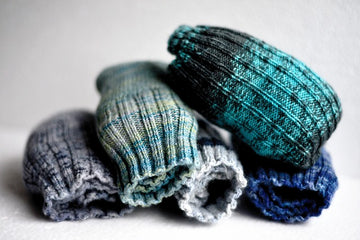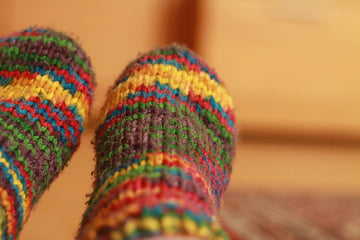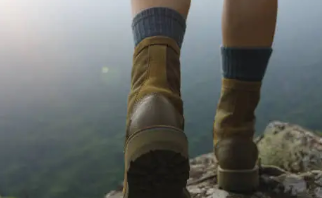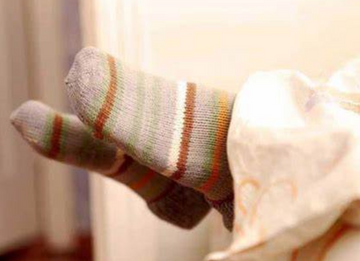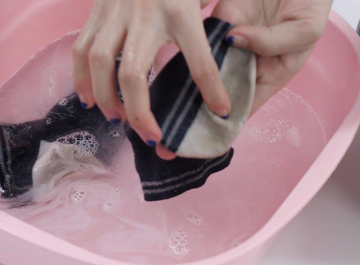
Socks, often overlooked in laundry routines, play a crucial role in foot hygiene and overall comfort. Proper sock care is essential to maintain their shape, color, and cleanliness. This guide delves into the intricacies of sock washing, from handwashing techniques to machine care, providing tips on water temperature, detergent use, and drying methods. Additionally, it covers common sock-related issues and their solutions, ensuring your socks remain in optimal condition.
Can I Wash My Socks by Hand
Yes, you can definitely wash your socks by hand! Hand washing your socks is a great way to extend their life and keep them looking their best. It's especially beneficial for delicate fabrics like wool or cashmere.
How to Wash Socks by Hand
Hand washing your socks can be a gentle way to care for delicate fabrics and extend their lifespan. By following these steps, you can keep your socks clean and in good condition.
Materials
- Mild laundry detergent or dish soap
- Sink or basin
- Cold water
Steps
- Fill the sink: With cold water. Warm water can shrink or fade your socks.
- Add detergent: A small amount of mild detergent or dish soap is sufficient.
- Turn socks inside out: This helps protect the outside of the sock and removes dirt from the inside.
- Soak: Allow the socks to soak for about 5-10 minutes to loosen dirt and grime.
- Scrub: Gently rub the socks together to remove any stubborn stains or dirt.
- Rinse: Thoroughly rinse the socks in cold water until all the soap is removed.
- Dry: Lay the socks flat to dry, or hang them to air dry. Avoid using a dryer, as the heat can damage the elastic.
Tips
- For heavily soiled socks, you can pre-treat stains with a stain remover before washing.
- If you have a lot of socks to wash, divide them into smaller batches for easier handling.
- To prevent socks from disappearing, consider using a mesh laundry bag.
Should I wash socks in hot or cold water?
It's generally best to wash socks in cold water. Overall, cold water is the safest choice for washing socks, especially if you want to preserve their fit, color, and elasticity. Here’s why:
- Prevents Shrinking: Cold water reduces the risk of shrinking, which is especially important for socks made from materials like wool or cotton.
- Maintains Color: Cold water helps prevent colors from fading or bleeding, keeping your socks looking new for longer.
- Protects Elasticity: The elastic fibers in socks can break down more quickly in hot water, so cold water helps maintain their shape and stretchiness.
When to Use Warm or Hot Water
- Heavily Soiled Socks: If your socks are extremely dirty or you’re dealing with stubborn stains, warm water (not hot) might be more effective.
- White Socks: Washing white socks in warm water can help keep them bright, but avoid using hot water, as it can still cause shrinkage or damage the fabric.
How to sanitize socks?
Sanitizing socks requires tailored care based on fabric and color. For white cotton socks, a hot water wash with chlorine bleach effectively kills germs. However, for colored or delicate socks, opt for non-chlorine bleach or a laundry sanitizer. Enhance the sanitizing process by adding white vinegar to the rinse cycle. Air drying or using low heat preserves fabric integrity. Essential oils like tea tree or eucalyptus can add deodorizing benefits. To prevent infection spread, wash infected socks separately.
Can you hand wash socks with dish soap?
Yes, you can hand wash socks with dish soap. Dish soap is a practical choice for hand washing socks when laundry detergent isn't available. Fill your sink with cold water and add a small amount of dish soap. Gently agitate your socks to remove dirt and grime. For stubborn stains, turn the socks inside out and repeat the process. Rinse thoroughly with cold water to eliminate any soap residue.
Should socks go in the dryer?
Socks can generally go in the dryer, but there are important considerations to keep in mind to preserve their lifespan. Proper sock drying is crucial for their longevity. Avoid high heat in the dryer, as it can damage delicate fibers, shrink wool, and weaken elastic. For most socks, a low heat setting is sufficient. However, air drying is always the gentlest option. Lay flat drying is best for wool and delicate fabrics like cashmere or silk. To protect the fabric and prevent pilling, turn socks inside out before drying.
Is it better to hand wash socks?
Handwashing is optimal for sock care, especially delicate ones. Gentle handling and cold water prevent damage and extend lifespan. However, for time constraints or larger loads, the delicate cycle is a viable alternative. Use cold water, turn socks inside out, and employ a mesh laundry bag to protect them. While machine washing offers convenience, handwashing remains superior for preserving sock quality.
Should socks be washed inside out?
Yes, washing your socks inside out is generally recommended. The inside of your socks comes into direct contact with your feet, where sweat and bacteria accumulate. Turning them inside out exposes these areas directly to the detergent, leading to a more thorough clean. Washing socks inside out can help prevent pilling on the outer fabric. Protecting the outer fabric from the washing machine's agitation can help your socks retain their color for longer. By taking this simple step, you can help your socks stay fresher, cleaner, and looking better for longer.
How often should I wash my socks?
Socks should generally be washed after each wear. Your feet produce a significant amount of sweat and bacteria, which can build up in your socks. Washing them regularly helps to prevent odor, fungal infections, and overall foot health.
Why are my socks crusty after washing?
Crusty socks after washing are often due to an excess of detergent. When too much detergent is used, it can build up on the fibers, making the socks feel stiff and harsh. Here are a few tips to prevent this issue. By adjusting these factors, you can keep your socks feeling soft and comfortable after each wash.
- Follow the manufacturer's guidelines for detergent use. Using less detergent can help avoid buildup.
- Ensure your socks are rinsed thoroughly to remove all detergent residue. Adding an extra rinse cycle can help.
- Fabric softeners can sometimes contribute to buildup on socks. If you're using them, try reducing the amount or avoiding them altogether.
- Washing in cold water can help prevent detergent from not dissolving properly, which reduces buildup.
Does vinegar clean socks?
Yes, vinegar can be effective in cleaning socks, particularly for brightening white socks and removing odors. The acetic acid in vinegar helps break down and remove dirt and grime. This method can help remove dinginess from white socks and deodorize them effectively.
- Boil Water: In a large container, bring several cups of water to a boil.
- Turn Off the Heat: Once the water reaches a boiling point, turn off the heat source.
- Add Socks and Vinegar: Add your dirty socks to the hot water. For added cleaning power, you can also add 1-2 cups of white vinegar (or cleaning vinegar).
- Soak: Allow the socks to soak in the water and vinegar mixture for about 30 minutes.
- Wash Normally: After soaking, wash the socks as usual in cold water with a small amount of detergent.
- Rinse Thoroughly: Make sure to rinse the socks thoroughly to remove any vinegar residue.
What happens if you don't wash your socks?
Not washing your socks regularly can lead to several issues. Dirty socks provide a breeding ground for bacteria and fungi, which can cause unpleasant odors and lead to infections like athlete's foot. Prolonged exposure to sweat and grime can irritate the skin on your feet, leading to rashes or sores. Accumulated sweat and bacteria can cause socks to develop a strong, unpleasant odor.
Why do people wash socks separately?
Washing socks separately from other laundry items is often done for a few reasons.
- Prevent Cross-Contamination
Socks and underwear, being worn closest to the body and often in direct contact with sweat and bacteria, can carry more germs. Washing them separately helps avoid cross-contamination with other clothing items.
- Protect Colors
Washing socks with other clothes, especially deep-colored items, can lead to color bleeding or dye transfer. By washing socks separately, particularly light-colored or white socks, you reduce the risk of colors fading or staining.
- Avoid Wear and Tear
Socks, especially those with elastic or delicate materials, can be damaged by washing with heavier items like jeans or jackets. Washing them separately minimizes friction and wear.
- Effective Cleaning
Washing similar items together ensures they are cleaned effectively. For example, socks can benefit from a specific wash cycle or detergent that’s tailored to their needs, which may differ from other clothing items.
Overall, washing socks separately helps maintain hygiene, protect colors, and preserve the quality of your clothing.
Final Words
By following the guidelines outlined in this guide, you can effectively care for your socks, extending their lifespan and maintaining their quality. Whether you prefer handwashing for delicate fabrics or rely on a washing machine for convenience, understanding the best practices will help keep your socks fresh, clean, and comfortable. With these tips, you can enjoy your socks for longer while maintaining optimal foot hygiene.
Read More:
Why Do We Wear Socks
Do You Wear Socks with Climbing Shoes
What Color Socks with Brown Shoes
What Socks to Wear with Loafers
What are Grip Socks
What Socks to Wear with Cowboy Boots
Are Wool Socks Good for Summer
What Color Socks with White Shoes
Why Do My Socks Keep Getting Holes



